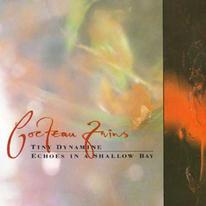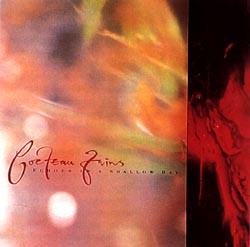
Pink Orange Red
Ribbed And Veined
Plain Tiger
Sultitan Itan


Great Spangled Fritillary
Melonella
Pale Clouded White
Eggs And Their Shells
Tiny Dynamine / Echoes In A Shallow Bay - 1985

|
Tiny Dynamine Pink Orange Red Ribbed And Veined Plain Tiger Sultitan Itan |

|

|
Echoes In A Shallow Bay Great Spangled Fritillary Melonella Pale Clouded White Eggs And Their Shells |
|
The EP's Tiny Dynamine and Echoes In A Shallow Bay were released simultaneously, and their sleeves wear very similar designs, which indicates their music should be interpreted as belonging together. The eight tracks do indeed sound as though they were created from a single concept, although in general those on Tiny Dynamine are somewhat louder and their sound more coherent than those on their somewhat softer and more diverse companion. The two EP's were later released on a single CD. On listening it is rather obvious the band is turning into a very different direction compared to Aikea-Guinea. The melodies are far more complex and the arrangements rather different: no loud guitars or heavy percussion and much more piano. In short their music on these EP's is far more acoustic than anything they had done to this point. Obviously then this was a major step to their ultimate acoustic album Victorialand. A striking feature of both EP's is that their titles and some of their lyrics are related to butterflies. Both a Plain Tiger and a Great Spangled Fritillary are species of butterflies, and so are a Pale Clouded Yellow and a White, which together seem to have inspired Liz to the song title Pale Clouded White. Melonella is part of a scientific butterfly name and so are all of its lyrics. Parts of most of the other song titles can easily be envisaged to be butterfly-related as well. And so on these two EP's we find the Cocteau Twins flying onto new musical horizons on wings of elegance and beauty. Both EP's were later also included in both The Box Set and the Lullabies To Violaine compilation. |
|
Pink Orange Red No complex melodies, no layers of sound or changing rhythms. The keyword to Pink Orange Red is simplicity. A simple yet delightful tune built around vocals and the straightforward kind of guitar that is so typical for the band on Tiny Dynamine. The song starts out with a single tremendous and instantly recognizable guitar riff, which although not played on an acoustic guitar succeeds very much in sounding like it is. Liz joins in with some very quiet vocals, the song speeds up a little bit, percussion is added, but the track still remains rather gentle for a long time. As ever, the band saved the best for last. The last minute suddenly buzzes with life. A choir impression, very quick vocals, everything comes together to provide a beautiful ending to this simple yet simply lovely song. Years later the band recorded an acoustic version for the Twinlights EP | ||||
|
Ribbed And Veined Named apparently after a phrase taken from When Mama Was Moth, Ribbed And Veined is a rare instrumental effort by the Cocteaus. It's not the only one, for they had earlier recorded My Hue And Cry and Rococo, and then of course there are also alternative instrumental versions of both Otterley and Oomingmak A sharp high-pitched guitar is easily the most conspicuous feature of this track. So much so does it take the starring role that one could easily think of it as a replacement for the vocals. It plays a single, deceptively simple theme only, and surprisingly it plays it no more then just ten times, but it still totally dominates this 'song'. And that is probably also the reason why we don't find any vocals here - it would be very hard to sing concurrently with such a penetrating guitar, and there's hardly enough room between the guitar parts. While featuring a nice sound and an easily recognizable theme, Ribbed And Veined is not a particularly striking track, and without Liz' vocals it's like an essential element is missing. The band wisely elected to use their available resources to the full from here on - this was to be the last instrumental the Cocteau Twins ever released. | ||||
|
Plain Tiger
The last two tracks of the Tiny Dynamine EP share a somewhat similar concept. Both songs feature a gentle and melodious theme mixed with a far more louder chorus. In Plain Tiger the two elements are quite different but go together rather well. The soft theme in Plain Tiger has a beautiful guitar sound with a steady bass and some very elegant percussion. Liz sings in 'fragility mode' - the kind of soft but still crystal clear vocals she delivers so well. While Liz is dreaming everything sounds peacefully and serene. But in the chorus Liz, as if suddenly woken up, treats us to much heavier vocal parts. At full volume, with lots of vocal overdub, she seems a different person, as if she has switched to 'Tiger mode'. Note also how well she is accompanied by some serious bass lines during these episodes. To put such different elements together is quite a task, and it must have taken the band quite some ingenuity to make the transitions between the softer and louder parts as smoothly as they are. But they succeeded quite well in creating unity from what are almost two entirely different songs. So although Plain Tiger may be a somewhat strange name for a butterfly it makes an excellent name for an intriguing song. | ||||
|
Sultitan Itan The title of this song, though probably meaningless, is yet another example of Liz' wordplay, since it does not appear in this song anywhere but can easily be detected in Pink Orange Red. The track contains two distinct themes, sounding very differently. On starting out we are treated to a wonderful little tune, very light and quick, embedded in beautifully arranged guitars and bass with just a bit of percussion. Just when everything appears to be peaceful the song suddenly comes up with a loud and heavy chorus, with Liz radically changing her vocal style from sweet and soft to loud and energetic. From here on the calm and quiet parts and the louder chorus are played alternately, yielding a song of contrast rather than of unity. Unlike in its companion track Plain Tiger though the band this time do not quite manage to combine two themes into a single composition. Sultitan Itan is a song difficult to appreciate to the full, because one is likely to prefer either theme very much to the other one. Perhaps the band consciously created a song of variation, or else their efforts for once did not quite yield the desired result. | ||||
|
Great Spangled Fritillary
If, after the release of Aikea-Guinea, anyone might have thought the band were likely to follow a more down to earth course from here on listening to Great Spangled Fritillary would soon have made them think again. The track appears shrouded in mystery, has a distinct oriental flavor and shows many unusual features. Gentle drumstick beats are all we here at first, until echoing drumbeats add an extra dimension. Soon the first interesting chords appear, but it is not until Liz starts singing that the track really gets going. She delivers both a slow and dramatic as well as a quicker and livelier melody, perfectly mixed together. Her lyrics are, as usual, impossible to follow, although it has been suggested that she is actually singing butterfly names. A Great Spangled Fritillary is, after all, a butterfly species. Nobody has been able to definitively decipher her words so far though. An amazing number of different guitar sounds can be detected all through the song, but a particularly swinging part introduces us to the final episode. Liz puts in a handful of extra volume and the song reaches an absolutely fantastic climax as her double vocals magically interact with each other and with all the surrounding guitars and percussion. Great Spangled Fritillary may be one of the bands most atypical songs, but at the same time it surely is one of the most brilliant efforts of their career. | ||||
|
Melonella References to butterflies are spread all over these two EP's, but in the case of Melonella we find this really taken to the extreme. The songs lyrics read like a butterfly textbook! The song title is mysterious enough by itself, but in a way it does give a clue. It was apparently derived from Galleria Mellonella (note the double 'l' though), the scientific name for a common but small and inconspicuous brown moth, also known as the Greater Wax Moth. But the lyrics tell an even more amazing story. For a start it's not too common to see the lyrics of any early Cocteau track, because most efforts to unravel Liz' vocals have proven to be futile. But in this case it's hardly surprising that for many years no one understood a syllable of this song. Eventually, and mostly by coincidence, the unbelievable lyrics were 'cracked' independently by Maor Avni and the author. Listen really carefully and you will hear that this is what she sings:
Many people may have a hard time believing it, but all 32 of these weird looking entries are in fact actual scientific butterfly family names! Some of them are mispronounced a bit, and in one or two cases Liz could even be singing a slightly different name (which hardly matters), but just read along with the song and the incomprehensible suddenly reveals its true if bizarre meaning. Liz may have produced some odd lyrics over the years, but a series of scientific butterfly names like this must surely be some kind of world record in lyrical improbability! Once you manage to turn your attention away from the lyrics you'll find there's actually a very worthwhile track behind all of Liz' wordplay. It's a rhythmic, jazz-influenced song, with nice vocals and clever overdub effects, working its way from a rather quiet beginning towards a louder conclusion. A background piano provides extra depth, blisteringly sharp guitar chords are mixed with much steadier quickfire parts, and the percussion is arranged so well it's once again hard to believe that it was probably all programmed rather than produced by an inspired drummer. Its extremely strange title would make this song stand out in most bands catalogues, and although it does take quite a bit more than that to be an uncommon Cocteau song, its perplexing lyrics surely rank Melonella among the top contenders for being the most unusual song in the Cocteau universe. | ||||
|
Pale Clouded White This is yet another track with a butterfly connection, since the title appears to be composed from Pale Clouded Yellow and White, both well known species of butterflies. It is not known whether the lyrics contain similar references - as usual one can hardly understand a syllable of them. From an arrangement point of view listening to this track is like a voyage of discovery, where new instruments can be detected every time. The song starts simple enough though, with a piano playing a catchy little theme in three time. This piano will manage to keep going almost the entire song - building up tension tremendously, almost demanding a change in rhythm or key and for long periods refusing to yield. The piano is accompanied by bass and some rather creative percussion with lots of little variations in both rhythm and instrumentation. It's not just the rhythm section that appears to be enjoying itself though. Liz produces some very fine vocals all along, and in particular in the chorus parts we encounter a host of different contributions. Electric and acoustic guitars, background clapping, the illusion of a grand choir, all melting together into a fantastic symphony. Halfway through, as though the song needs to catch its breath from such instrumental wizardry, an instrumental part is inserted. The piano is once more the steady force here, keeping the track going, with just some additional melancholic melodies from an electric guitar and a few synthesizer sound effects. The other instruments eventually join in again for a final jubilant chorus. Liz then repeats the last line once more, the guitars die away, and even the piano finally gives up as the song, having spent all its musical ammunition, draws to a close. | ||||
|
Eggs And Their Shells Eggs - and especially their shells - are usually thought of as very fragile. And fragility is a pretty good description for the mood of this song. Although the first few notes sound pretty firm Liz soon paints a different picture. This is a beautiful rather than an exciting song, a lovely, quiet effort, with sweet and delicate vocals. No powerful chords anywhere, just gentle percussion and softly wailing guitars. No vocal overdubs either, everything is kept to a bare minimum it seems. Towards the end the bass takes over as the leading instrument, but its contributions are in perfect harmony with the rest of the song. So, is it the naivety of Liz' vocals in the chorus? Or could it be the sparseness and simplicity of the percussion? Eggs And Their Shells is 'only' a fairly straightforward three-minute composition - a verse and a chorus, both played just twice. There doesn't appear to happen anything special or exceptional at all. And yet the band convincingly succeeds to convey an atmosphere of elegance and beauty. It's part of their magic that they were able to do so time and again with apparently so little effort. |